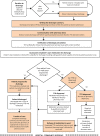Hospital patient discharge process: an evaluation
- PMID: 31156958
- PMCID: PMC6451602
- DOI: 10.1136/ejhpharm-2016-000928
Hospital patient discharge process: an evaluation
Abstract
Objectives: Medication discrepancies for patients after discharge from hospital are well documented. They have been shown to cause unnecessary harm to patients and can result in hospital readmission. To improve patient discharge, the current process of discharging patients from hospital (the discharge process) needs evaluating to determine where and why medication issues occur. This study aimed to identify and evaluate the discharge process used in a range of acute National Health Service hospitals across the North West of England.
Methods: This qualitative study involved semi-structured telephone interviews with 13 chief pharmacists or an appropriately nominated member of the hospital pharmacy team. Thematic analysis of the transcribed interview data was performed. Data analysis revealed eight main themes which all impacted on the discharge process.
Results: The study was successful in identifying the discharge process across the range of hospitals as well as key issues and examples of good practice. The hospitals involved in the study were found to have similar discharge processes with issues common to all. One significant finding was a lack of patient involvement in the discharge process.
Conclusions: To improve the patient discharge process, innovative solutions are required to overcome the current issues. In future work, the study findings will be used to develop a new model of care for patient discharge from hospital.
Keywords: CLINICAL PHARMACY; MEDICAL ERRORS; QUALITATIVE RESEARCH; RESEARCH AND TEACHING.
Conflict of interest statement
Competing interests: None declared.
Figures
References
-
- BMA Patient Liaison Group. Hospital discharge: the patient, carer and doctor perspective. London: BMA, 2014.
-
- Health and Social Care Information Centre (HSCIC), Academy of Medical Royal Colleges. Standards for the clinical structure and content of patient records. London: HSCIC, 2013.
-
- Royal Pharmaceutical Society. Keeping patients safe when they transfer between care providers—getting the medicines right. 2012. http://www.rpharms.com/current-campaigns-pdfs/rps-transfer-of-care-final...
-
- Duggan C, Feldman R, Hough J, et al. . Reducing adverse prescribing discrepancies following hospital discharge. Int J Pharm Pract 1998. 6:77–82. 10.1111/j.2042-7174.1998.tb00920.x - DOI
-
- Jennings E. A pharmacist who makes home visits. J Am Soc Aging 2012;35:72–4.
LinkOut - more resources
Full Text Sources

